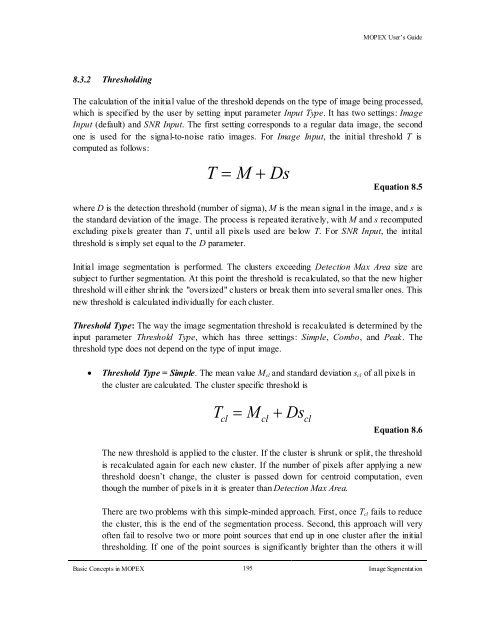Create successful ePaper yourself
Turn your PDF publications into a flip-book with our unique Google optimized e-Paper software.
8.3.2 Thresholding<br />
<strong>MOPEX</strong> User’s <strong>Guide</strong><br />
The calculation of the initial value of the threshold depends on the type of image being processed,<br />
which is specified by the user by setting input parameter Input Type. It has two settings: Image<br />
Input (default) and SNR Input. The first setting corresponds to a regular data image, the second<br />
one is used for the signal-to-noise ratio images. For Image Input, the initial threshold T is<br />
computed as follows:<br />
T = M + Ds<br />
Equation 8.5<br />
where D is the detection threshold (number of sigma), M is the mean signal in the image, and s is<br />
the standard deviation of the image. The process is repeated iteratively, with M and s recomputed<br />
excluding pixels greater than T, until all pixels used are below T. For SNR Input, the intital<br />
threshold is simply set equal to the D parameter.<br />
Initial image segmentation is performed. The clusters exceeding Detection Max Area size are<br />
subject to further segmentation. At this point the threshold is recalculated, so that the new higher<br />
threshold will either shrink the "oversized" clusters or break them into several smaller ones. This<br />
new threshold is calculated individually for each cluster.<br />
Threshold Type: The way the image segmentation threshold is recalculated is determined by the<br />
input parameter Threshold Type, which has three settings: Simple, Combo, and Peak. The<br />
threshold type does not depend on the type of input image.<br />
• Threshold Type = Simple. The mean value Mcl and standard deviation scl of all pixe ls in<br />
the cluster are calculated. The cluster specific threshold is<br />
T cl = M cl + Ds cl<br />
Equation 8.6<br />
The new threshold is applied to the cluster. If the cluster is shrunk or split, the threshold<br />
is recalculated again for each new cluster. If the number of pixels after applying a new<br />
threshold doesn’t change, the cluster is passed down for centroid computation, even<br />
though the number of pixels in it is greater than Detection Max Area.<br />
There are two problems with this simple-minded approach. First, once Tcl fails to reduce<br />
the cluster, this is the end of the segmentation process. Second, this approach will very<br />
often fail to resolve two or more point sources that end up in one cluster after the initial<br />
thresholding. If one of the point sources is significantly brighter than the others it will<br />
Basic Concepts in <strong>MOPEX</strong> 195<br />
Image Segmentation





